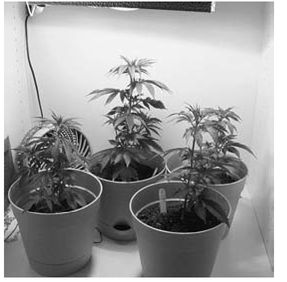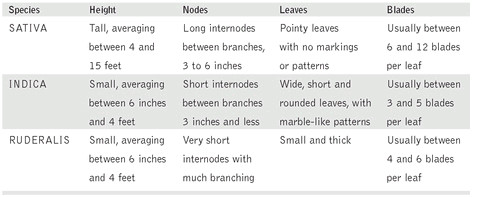The Cannabis Breeder's Bible (4 page)
Read The Cannabis Breeder's Bible Online
Authors: Greg Green

Some breeders decide to sell their own produce without the aid of a seed bank. They do this by setting up a point of sale on the internet or by using a P.O. box address. Most of their advertising is done by word of mouth. Here are the advantages and disadvantages of each method.
Seed Resellers (Seed Banks)
1. Give a percentage based on sales figures.
2. Require testing of your produce before they sell it.
3. Set a fixed price.
4. Sometimes require that you share the product rights with them to prevent you from selling your work elsewhere.
5. Do the advertising for you and promote your work.
6. Act as a point of contact between you and the client, keeping your identity closely guarded.
Self-Marketing
1. You always receive 100% of the money from sales.
2. You do not need to have people test your product before you can sell it.
3. You choose the price.
4. You retain the exclusive rights to your work.
5. You do the advertising.
6. Your identity may be hard to keep undisclosed.
As you can see each method has some good points and some bad points. These pros and cons also depend on the type of seed bank or breeder involved. Most breeders start in the game by giving their seeds away to growers for free before starting to sell their stock. This helps them generate some feedback and also helps them to understand more about consumers and what they like.
Many message board Websites on the internet with large memberships offer these testing services for free.You should try them out if you are interested in getting into the game.
http://www.cannabisbook.com
—Greg Green Cannabis Grow Forums and Website
http://www.hightimes.com
—High Times Magazine
http://www.marijuananews.com
—Marijuana News and Legal Information
http://www.cannabistimes.com
—Cannabis Times Newspaper
http://www.cannabis.com
—General Cannabis Information Website
http://www.yahooka.com
—General Cannabis Information Website
http://www.cannabisculture.com
—Cannabis Culture Magazine
http://www.overgrow.com
—Cannabis Growing Website
http://www.cannabisworld.com
—Cannabis Growing Website
http://www.growadvice.com
—Cannabis Growing Website
http://www.cannabishealth.com
—Cannabis Health Website
http://www.erowid.org
—Drug Information Website
http://www.lycaeum.org
—Drug Information Website
Your marketing campaign will be aimed at letting people know about you and your strains. You may have to enter cannabis cup competitions and even hand a large quantity of your seeds out for free before you generate any real interest.
If you choose to go the resale route, here are some things that you should know about seed banks before you contact them.
• With a seed bank there is only one knowledgeable person who deals with seed sales—the owner. You should only contact the owner with any queries about selling your seeds. Never deal with anyone else.
• The owner will always use another breeder to test your seeds. You may even be asked to test another breeder’s seeds yourself for the owner if you build up a reputation with the seed bank. Remember that the other breeder who will be testing your strain is someone who is respected by the seed bank for his breeding and growing skills.
• Always buy from the seed bank before you ask if you can sell your seeds to them. Buying more than once from them establishes a relationship with the seed bank. It teaches you how they treat their clients and how they ship your seeds. You can also grow out the seeds and check to see if their seeds meet your standards or if yours meet theirs.
• Be aware that when you sell your stock to a seed bank it can take anywhere to a year before the seed bank publishes your strain in its catalogues. This is because seed banks will require a period of testing and evaluation of your produce. You may end up spending a lot of money on developing and sending them seeds.
• The seed bank may ask for exclusive rights and the right to sell your product abroad. The seed bank may ask to simply buy the strain from you outright. They will then breed it under their own name. Or they may just wish to buy the rights for their sales regions, leaving other regions free for you to sell to.
• The big names in the seed bank business never fail. They are only getting bigger. Remember though that your strain may disappear among the vastness of their catalogues.
• You may have to sign a very real contract.
Apart from the commercial aspect, you should be breeding cannabis for yourself and your friends. Most breeders are more than happy to do this just as a hobby and not for profit.
WHY SHOULD WE BREED CANNABIS?
This is the foremost question that a breeder should be asking himself before engaging in a breeding project. It will establish the premise for his breeding ambitions, which may continue for a number of years, with improvements aimed at achieving their objectives along the way. Why should we bother breeding a new strain of Skunk if more than two dozen Skunk strains already exist? Why bother breeding another version of Blueberry when more than thirty Blueberry hybrids already exist? What is the purpose behind creating another Northern Lights hybrid when there are so many NL hybrids on the market?
There are plenty of reasons why breeders should not get involved in a five-year breeding program to begin with, however there are some core reasons why we should breed cannabis plants.
1. To improve a strain’s qualities and lock down a trait we like.
2. To create something new.
3. To reproduce something that is lost.
4. To help create strains suitable for specific growing environments.
Let’s examine these reasons more closely.
1.
To improve a strain’s qualities and lock down a trait we like:
We may have obtained a strain that we like, but in its offspring we may notice that certain traits are variable, such as potency, flavor or color. We may actually find in the offspring a trait that is better than what the parent plants had to offer. We may find that some of our plants are more potent than the rest.
Since it seems that what we are seeing is a trait that the original breeder did not breed for but is something that we think improves the strain, we can breed this trait true in future populations of this strain. This is why we have so many variations of certain strains like NL#5 and NL#9. When we have identified the trait that we like in the plant we will use breeding techniques to lock down this trait so that any future offspring will only show this specific trait without any variations. This is especially true for strains that are almost stable but contain some variations. When a trait is continued in the offspring without variations the trait is known as true breeding.
2.
To create something new:
The market demands change and growers tire of seeing the same strains over and over again. By breeding strains we can create new hybrids for the market.
If the strain is good the market will respond well. A new addition to the market recently is Blueberry which has done very well. Since then we have even seen numerous hybrid Blueberry plants appear on the market, such as Flo and Shishkeberry.
3.
To reproduce something that is lost:
It does happen that for some reason or another a breeder pulls out of breeding or loses the original parents of a particular strain. If such a situation should arise the breeding community may try to restore the strain again by using genetic material that is related to the lost strain. If both the original parents are completely gone then this can be a very hard task.
4.
To help create strains suitable for specific growing environments:
By breeding a strain under certain conditions we can actually create a strain that grows best under those conditions. Since what we observe in a plant’s character is partially genetic and partially due to the growing environment, we tend to breed for traits that are influenced by that environment.
That is why so many strains are labeled as outdoor strains, indoor strains and greenhouse strains. Some strains are even created to suit specific types of grow methods such as
SOG
,
ScrOG
and
cabinet growing
(
CGB,
pp. 115-19).
If you breed a strain for indoor SOG growing then you are automatically isolating that strain to a specific type of market. Sometimes this can work out very well and sometimes not. Consider the following.
• New growers will probably grow out something like Skunk#1 because seed banks advise them to do so. Skunk#1 is a very stable strain and is very good for the beginner grower because it is easy to grow. The same goes for Northern Lights and Afghani#1.
• Top 44 is a very small plant. It can be flowered completely at only a foot or two in height. Thus it can be grown in very small spaces and is most suitable for that environment. It is also the quickest flowering strain and will finish in 44 days or less—hence the name Top 44.
• Cindy 99, is a plant that does very well in ScrOG setups. Nearly everyone who does ScrOG has tried Cindy 99.
Some nice short Indica plants that are bred for small spaces. Photo by Joe Schmoe.

These are some reasons why we breed cannabis plants and how we can breed cannabis plants to suit a certain area of the market. As a breeder you will probably want to seriously explore these points before you breed anything that you want to sell.
Most good breeders are serious growers or have been growing for quite a number of years. Through their growing experiences they find areas of the market that lack strains to meet their particular tastes and needs. This is when a breeder may develop a winning strain that suits a certain market area.
Breeding is also about knowing when and why you should develop a strain. If you can give good REASONS for creating your strain then you will draw interest to your project.
BREEDING FOR YOURSELF
Some strains that have taken the market by storm have not been planned for the market. A breeder may create a strain ‘on the fly’ and suddenly find that people like it and want to buy it. This type of breeding is hit or miss and you may have to develop twenty or more strains before one of them is discovered as being very suitable for a market area.
THE BASIC CONCEPT OF CANNABIS BREEDING
Cannabis strains are, quite simply, recombinations of each other’s genetic material. Actually every cannabis strain is a recombination of cannabis genetic material, but in terms of pure species types, i.e., Pure Indica, Pure Sativa, Pure Ruderalis, they are a recombination of genetic material from that pure species type without influence from another species. That is what makes them pure lines.
All the genes for every cannabis strain stem from the pure species type gene pools.
The pure species types are the building blocks behind the
mostly
-type strains, i.e., Mostly Indica, Mostly Sativa, Mostly Ruderalis. Without the pure species types we would not have the
mostly
strains. The following chapter will help to explain this further as well.
CANNABIS SPECIES
Originally cannabis was classed by biologists as just
Cannabis Sativa L.
However, today’s cannabis researcher has seen this classification further divide into three main species of cannabis that occur naturally in the wild. These are:
Cannabis Sativa, Cannabis Indica
and
Cannabis Ruderalis.
SPECIES DESCRIPTION TABLE

